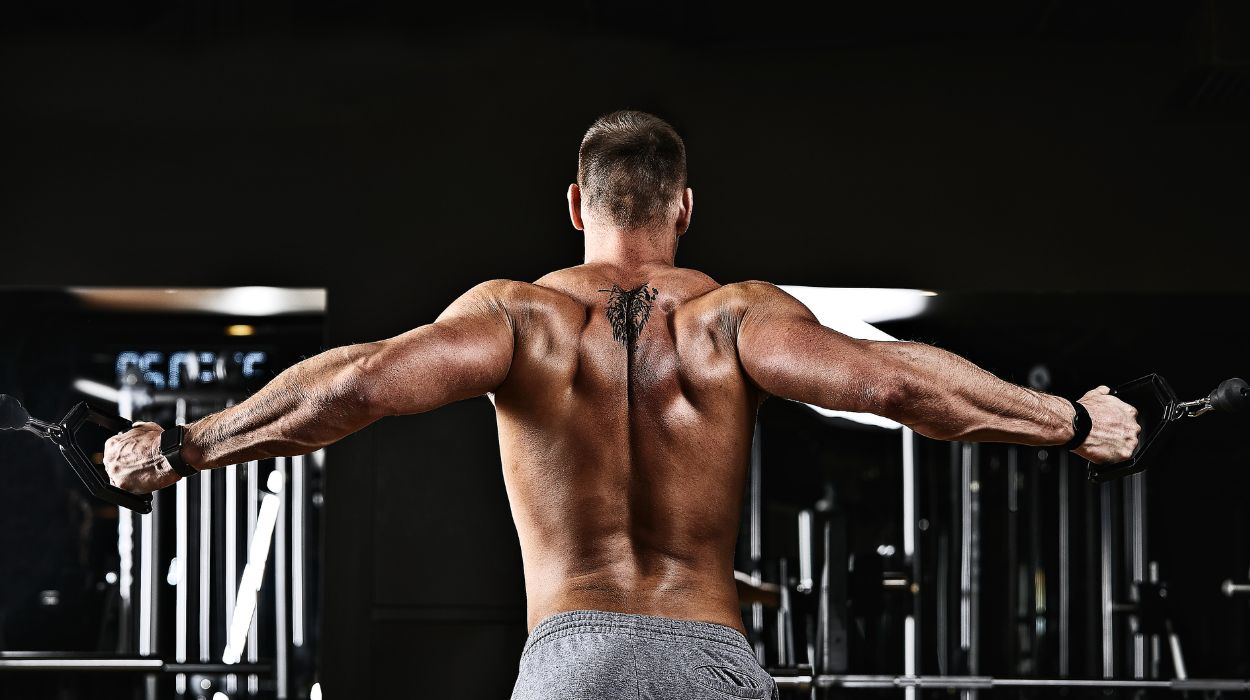
When you embark on enhancing shoulder mass and strength, choosing the right exercises is critical. The best shoulder workout for mass combines strength, aesthetics, and functionality in your routine. These shoulder workouts, diverse in approach, cater to varying skill levels and goals, ensuring a well-rounded development.
As you start down this path, remember that each movement is selected to foster robust shoulder growth. By focusing on tailored exercises, you ensure a balanced, effective path toward well-defined shoulders. For more details, explore these expertly designed routines, ideal for maximizing muscle growth and strength.
Top Shoulder Workouts For Mass
- Seated Barbell Press: Enhances overall shoulder strength and stability.
- Standing Lateral Raise: Widens and shapes the shoulder silhouette.
- Standing Dumbbell Upright Row: Builds mass and upper body strength.
- Standing Cable Rear Delt Fly: Balances muscle development and improves posture.
- Seated Arnold Press: Targets all deltoid heads for comprehensive growth.
Best Shoulder Workout For Mass In 2024
Building shoulder mass requires a balanced combination of exercises targeting various muscle groups within the shoulder.
Seated Barbell Shoulder Press
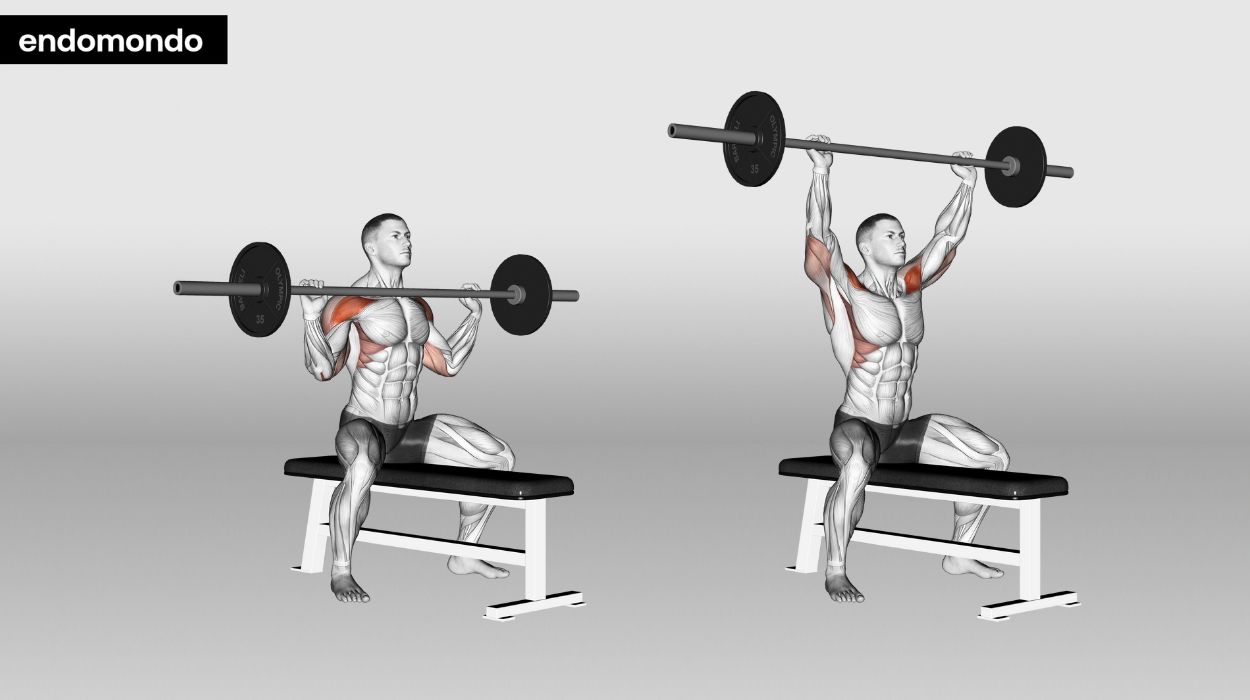
The seated barbell press stands as a cornerstone in shoulder development regimens, respected for its uncomplicated yet effective mechanics. This exercise, executed from a position of stability, allows for a targeted intensification of the anterior and medial deltoids.[1]
The benefits unfold as you lift; not only does it enhance muscular mass, but it also fortifies the stability of shoulder joints. Incorporating the seated barbell press into your shoulder routine for mass can significantly increase overall shoulder strength-a key component for functional upper-body movements.
Furthermore, the support provided by the bench aids in minimizing the risk of lower back strain, making it a safe choice for heavy lifting. This exercise’s inclusion in a barbell shoulder workout ensures a balanced strength gain.
How to do:
- Sit on a bench with back support, positioning your feet firmly on the floor for stability.
- Grip the barbell with hands just wider than shoulder-width apart, and hold it at shoulder height with your wrists straight.
- Brace your core and press the barbell upward in a vertical line, exhaling as you do so.
- Extend your arms completely at the top without locking out your elbows.
- Pause briefly at the peak, then inhale as you lower the barbell back to the starting position with control.
- Ensure the barbell moves downward in the same vertical path, avoiding any forward or backward motion.
- Keep your back neutral, resisting the urge to arch your spine as you press.
- After completing the desired reps, safely rack the barbell before standing up from the bench.
Tips:
- Start with lighter weights to perfect the form.
- Engage your core for stability.
Optimal Sets and Reps: 4 sets of 8-10 reps.
Standing Dumbbell Lateral Raise
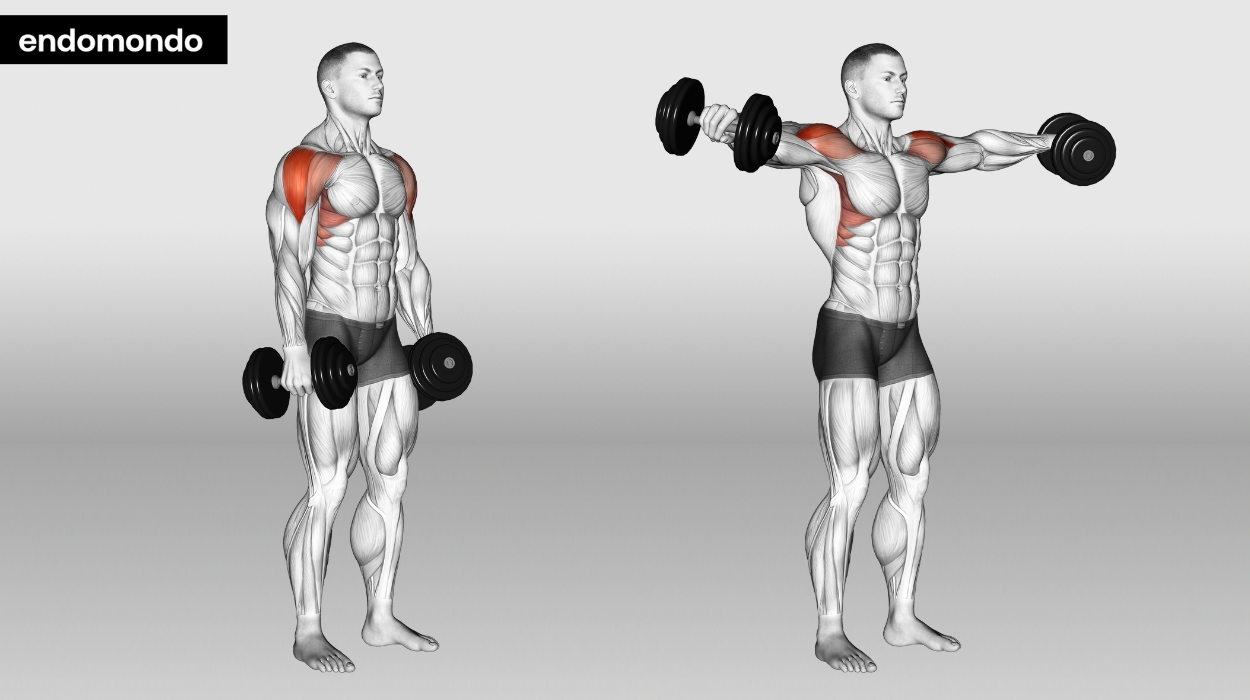
The Lateral Raise is a strategic exercise that meticulously carves out the medial deltoids, contributing to the width and shape of the shoulders. This targeted movement accentuates the shoulder’s profile and fortifies the musculature essential for arm lifting and horizontal abduction.
By integrating lateral raises into your shoulder exercises with dumbbells, you address muscle symmetry and functional strength. The movement’s true merit lies in bolstering the deltoids without imposing undue stress on the surrounding joints. That makes it a staple for shoulder exercises for mass.
It’s a testament to the precision required in a well-structured shoulder routine for mass. Each repetition brings you closer to the desired muscularity and balance.
How to do:
- Stand with feet shoulder-width apart, holding a dumbbell in each hand at your sides.
- With a slight bend in your elbows, lift the dumbbells out to the sides, keeping your palms facing down.
- Raise the weights until they are parallel to the floor, and your body forms a ‘T‘ shape.
- Pause at the top of the movement, then slowly lower the dumbbells back to the starting position.
- Keep your torso stationary throughout the lift; the movement should occur only at the shoulder joint.
Tips:
- Keep the core engaged to stabilize the body throughout the exercise.
- Avoid swinging the weights; use a deliberate, controlled movement.
- Do not lift the dumbbells higher than the shoulder level to maintain focus on the deltoids and prevent injury.
Optimal Sets and Reps: 3-4 sets of 10-15 reps.
Standing Dumbbell Upright Row
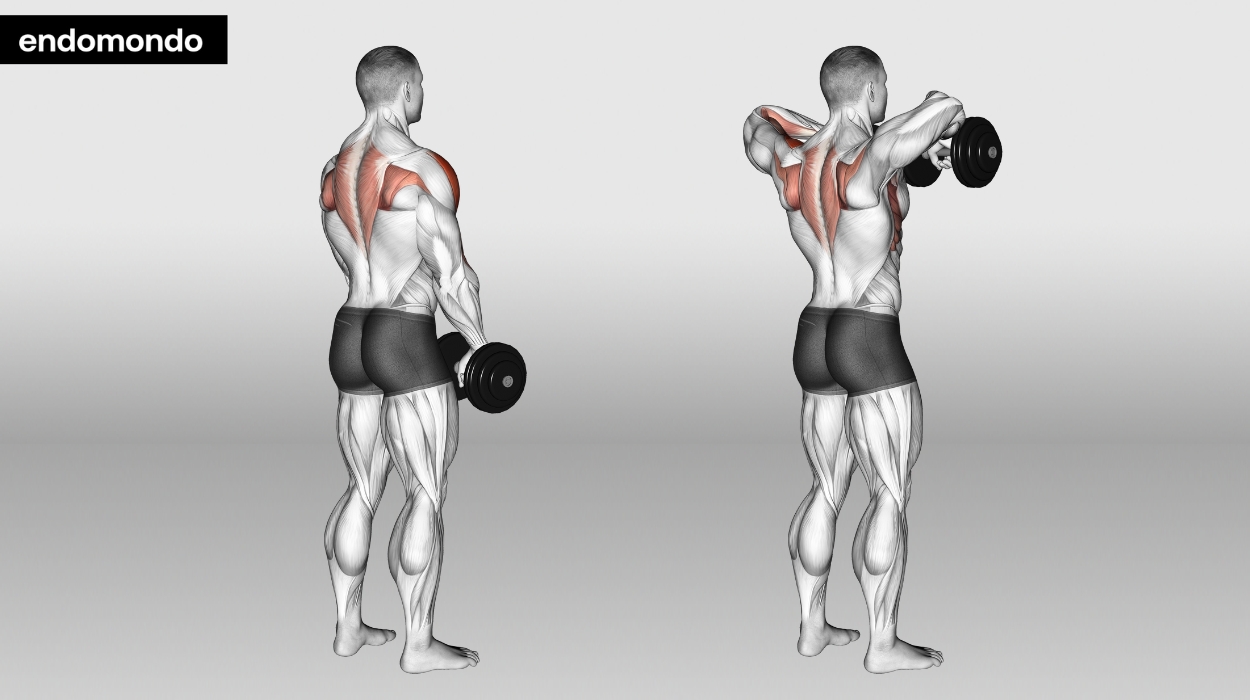
The Dumbbell Upright Row is a dynamic exercise that engages upper body muscles, primarily the traps and the deltoids. This compound movement contributes to mass building and enhances upper body strength, which is critical for a variety of physical tasks.
When included in exercises for shoulder mass, the dumbbell upright row is a powerhouse. It encourages a robust upper body and contributes to a balanced physique. It offers substantial functional benefits with a comprehensive workout that fosters strength that supports both day-to-day activities and athletic performance.
How to do:
- Stand upright with feet shoulder-width apart, holding a dumbbell in each hand with arms straight in front of you.
- With palms facing your body, lift the dumbbells vertically, leading with your elbows.
- Raise the weights just under chin level while maintaining balanced shoulders and keeping the dumbbells close to your body.
- Pause briefly with the shoulder-high dumbbells, then slowly lower them back to the starting position.
- Ensure that your elbows always remain higher than your forearms during the lift.
Tips:
- Keep the movement controlled and avoid jerking the weights to prevent momentum from taking over.
- Lead with the elbows and ensure they always remain higher than the forearms.
- Refrain from lifting the weights too high to avoid shoulder impingement.
Optimal Sets and Reps: 3 sets of 8-12 reps with moderate weight.
Standing Cable Rear Delt Fly
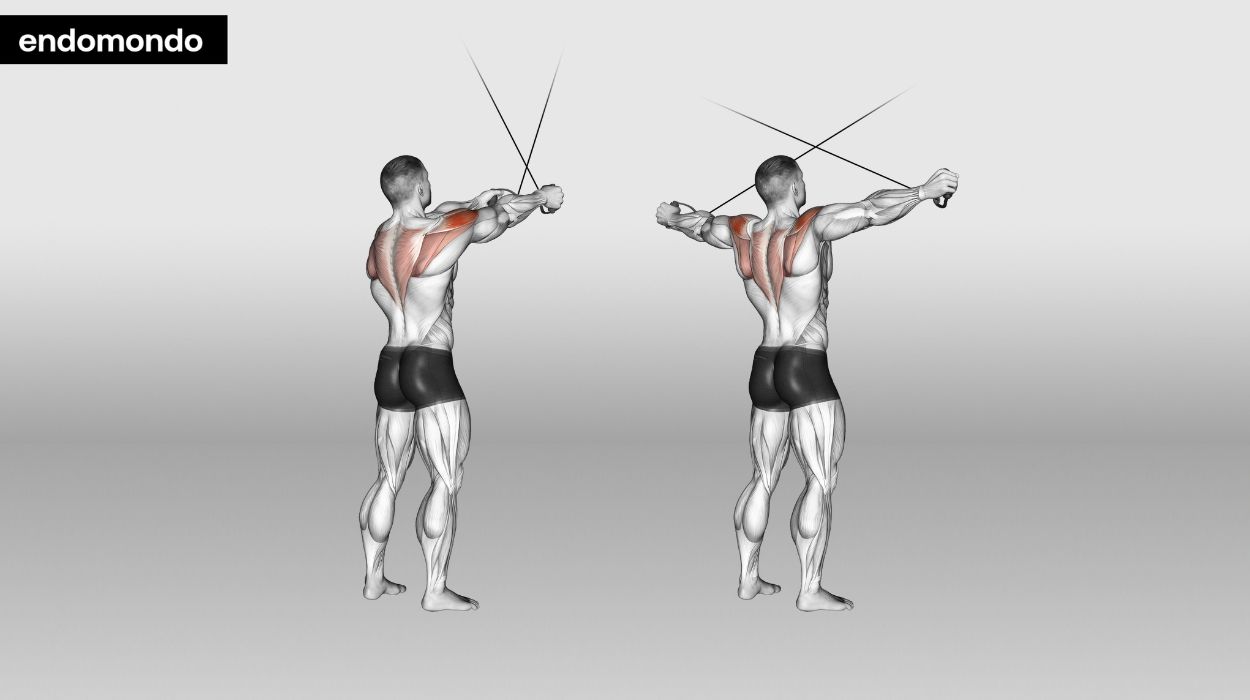
The Cable Rear Delt Fly zeroes in on the posterior deltoids, a group often overlooked in standard shoulder training. This rear delt exercise is pivotal for creating a balanced musculature across the shoulder girdle, essential for both posture and performance.
As a part of cable shoulder workouts, it ensures that you’re not just building mass but also enhancing the functional capabilities of your shoulders. The controlled tension provided by the cable machine aids in maintaining constant muscle activation throughout the movement. This leads to superior muscle engagement and growth.
By incorporating this exercise, you’re refining the rear silhouette of your shoulders and contributing to harmonious upper body strength.
How to do:
- Adjust the pulleys to shoulder height and select the appropriate weight on both sides.
- Stand in the center of the cable machine, grasping the left handle with your right hand and the right handle with your left hand, crossing them in an ‘X‘.
- With a slight bend in your elbows, lean forward slightly at the hips, keeping your back straight.
- Open your arms out to the sides, pulling the handles apart horizontally until they are in line with your shoulders.
- Squeeze your shoulder blades together at the end of the movement.
- Slowly return the handles to the starting position, maintaining tension on the deltoids.
Tips:
- Keep your chest up and shoulders back to fully engage the rear delts.
- Avoid using excessive weight, which can lead to overcompensation with other muscles.
- Concentrate on the mind-muscle connection, focusing on the rear delts throughout the exercise.
Optimal Sets and Reps: 3-4 sets of 12-15 reps with a weight that challenges the final reps.
Seated Arnold Press
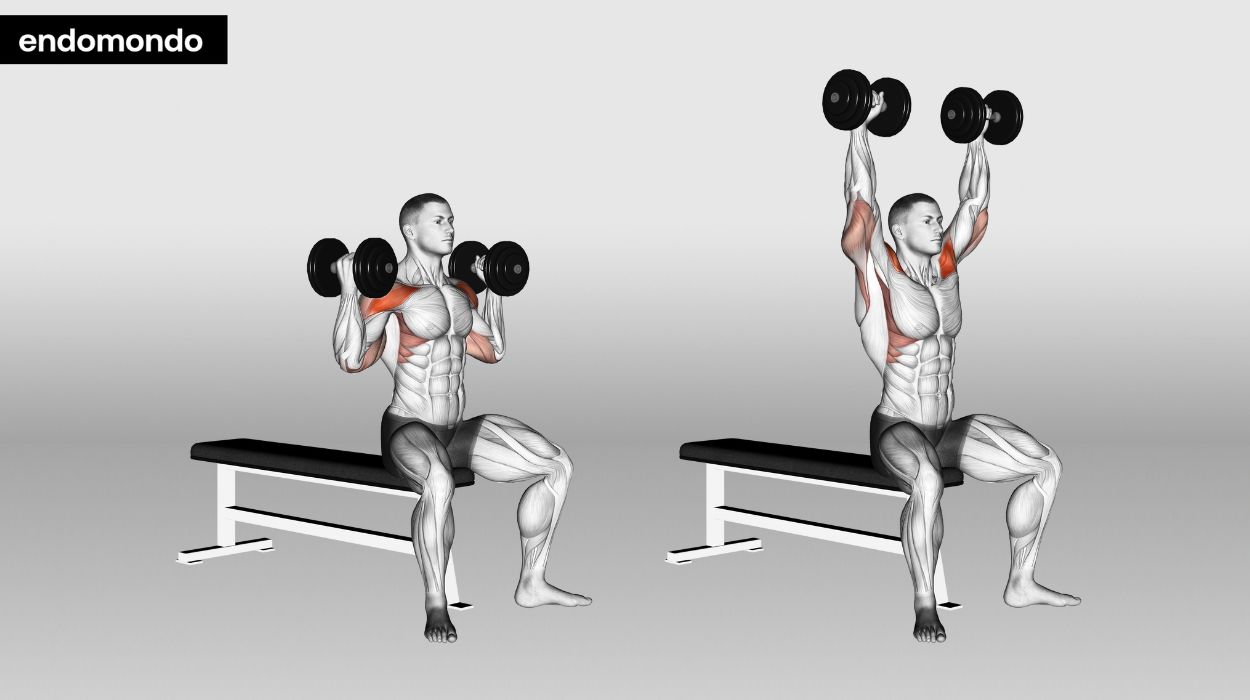
The Arnold Press is a comprehensive seated barbell press exercise that brings a dynamic challenge to the entire deltoid region. By rotating the palms during the movement, you engage all three heads of the deltoid muscle. That makes it a superb addition to front delt workouts and push-day workout routines.
This versatile exercise goes beyond typical pressing movements, offering a unique combination of rotation and elevation. It stimulates muscle fibers from multiple angles.
With the Arnold Press, you gain the advantage of a compound movement that encourages mass and enhances shoulder mobility and overall joint health. Its inclusion in an arm and shoulder workout is key for achieving a symmetrical and powerful upper body.
How to do:
- Sit on an exercise bench with back support, holding a dumbbell in each hand at chest level.
- Start with your palms facing your body and elbows bent under the dumbbells.
- During the upward motion, twist your wrists to transition your palms to face towards you at the peak of the lift.
- Extend your arms fully overhead without locking the elbows.
- Reverse the motion by lowering the dumbbells back to chest level while rotating your palms back toward you.
- Keep a controlled pace and steady breathing throughout the exercise.
Tips:
- Ensure a smooth transition as you rotate your wrists during the press.
- Do not rush the movement; maintain a steady, controlled tempo.
- Keep the back straight and avoid arching during the overhead press.
Optimal Sets and Reps: 4 sets of 6-10 reps.
Shoulder Anatomy
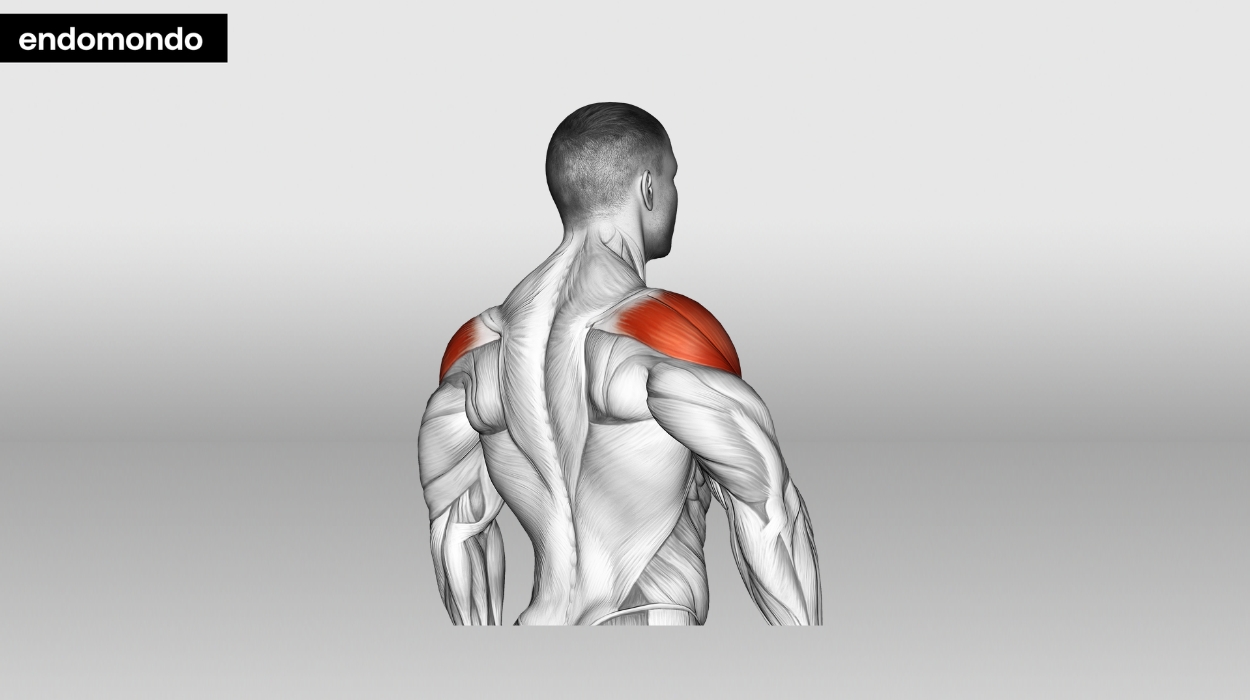
If you’re aiming to build shoulder mass, a clear understanding of shoulder anatomy is a strong advantage. It’s not just about lifting weights; it’s about fostering a deep connection between your mind and muscles.
- Bones: The clavicle, scapula, and humerus form the scaffolding of your shoulder, a framework that supports all your movements.
- Joints: Your shoulder joints, hubs of activity, allow the arm to move in almost any direction, a testament to its remarkable design.
- Muscles: The front and rear deltoids are the stars here. They cap your upper arm and are split into three heads, each responsible for different movements.
- Support: Underneath, the rotator cuff muscles act as stabilizers,[2] keeping your arm bone firmly in place as you move.
When you grasp the intricate play of bones and muscles, each movement brings you closer to your goal.
Tips For Shoulder Muscle Growth
Implementing strategic tips can make all the difference for those dedicated to expanding shoulder muscle. Effective growth is more than just picking up free weights; it’s about an informed approach that marries consistency with smart training.
Gradual Overload
Progressively increases the weight or resistance to challenge your shoulders. This gradual increase stimulates muscle adaptation and growth[3] over time, which is essential for a shoulder workout for mass.
Mind-Muscle Connection
Focus on the feeling in your shoulder muscles during each rep. This conscious engagement can lead to more effective workouts and better results.
Rest And Recovery
Give your shoulders adequate time to rest between trying the best shoulder workouts for mass. Muscle mass growth occurs during recovery, not just during exertion. Adequate rest should also be given between sets.[4]
Nutrition And Hydration
Feed your muscles with a balanced diet rich in protein, complex carbohydrates, and healthy fats. Staying well-hydrated is equally important for muscle function and repair.[5]
Remember, shoulder muscle mass growth is a journey. By following these guidelines, you’ll not only see improvement in mass but also in overall shoulder health and function.
Conclusion
As you incorporate these principles into your training, remember that building shoulder mass is a balance of dedication, technique, and rest. Commit to your shoulder routine for mass with persistence and patience, and the results will follow.
Nurture your body with the right nutrients, allow for recovery, and continuously challenge your muscles with your shoulder workout routine. Combine these elements with a consistent workout schedule to build not just strength but also the resilience of your shoulders. Let your efforts match your attempts in the gym in recovery and nutrition, and watch as your shoulders transform.
Frequently Asked Questions
Exercises like the seated barbell press, lateral raises, and upright rows are highly effective.
Combine compound and isolation exercises with proper nutrition and rest.
Yes, if you’re including compound movements and maintaining intensity.
The Arnold press effectively targets all three deltoid heads.
It can be challenging due to the complexity of shoulder muscles, but with the right routine, progress is achievable.
Training shoulders 2-3 times a week with proper rest can yield significant results.
Resources
- Yuri, Vianna, J.M., Guimarães, M.P., Jorge, Hernández-Mosqueira, C., Silva and Marchetti, P.H. (2020). Different Shoulder Exercises Affect the Activation of Deltoid Portions in Resistance-Trained Individuals. Journal of Human Kinetics, [online] 75(1), pp.5–14. doi:https://doi.org/10.2478/hukin-2020-0033.
- Sangeeta Sangwan, Green, R.A. and Taylor, N.F. (2014). Stabilizing characteristics of rotator cuff muscles: a systematic review. Disability and Rehabilitation, [online] 37(12), pp.1033–1043. doi:https://doi.org/10.3109/09638288.2014.949357.
- Plotkin, D., Coleman, M., Derrick Van Every, Maldonado, J., Oberlin, D., Israetel, M., Feather, J., Alto, A., Vigotsky, A.D. and Schoenfeld, B.J. (2022). Progressive overload without progressing load? The effects of load or repetition progression on muscular adaptations. PeerJ, [online] 10, pp.e14142–e14142. doi:https://doi.org/10.7717/peerj.14142.
- McKendry, J., Pérez-López, A., McLeod, M., Luo, D., Dent, J.R., Benoit Smeuninx, Yu, J., Taylor, A.E., Philp, A. and Breen, L. (2016). Short inter‐set rest blunts resistance exercise‐induced increases in myofibrillar protein synthesis and intracellular signalling in young males. Experimental Physiology, [online] 101(7), pp.866–882. doi:https://doi.org/10.1113/ep085647.
- Judge, L.W., Bellar, D.M., Popp, J.K., Craig, B.W., Schoeff, M.A., Hoover, D.L., Fox, B., Kistler, B.M. and Al-Nawaiseh, A.M. (2021). Hydration to Maximize Performance And Recovery: Knowledge, Attitudes, and Behaviors Among Collegiate Track and Field Throwers. Journal of Human Kinetics, [online] 79, pp.111–122. doi:https://doi.org/10.2478/hukin-2021-0065.




